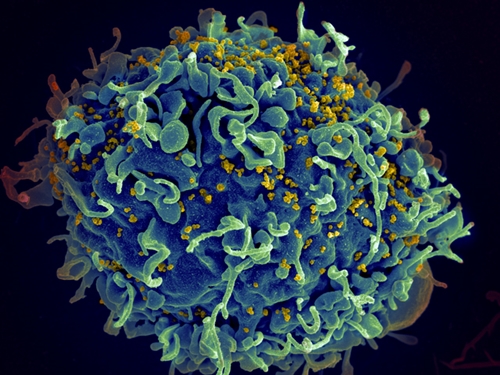10 January 2018. Medical and engineering researchers developed and tested in pigs a technique for packing several drugs into a capsule taken once a week to prevent and treat HIV infections. The team from Massachusetts Institute of Technology and Brigham and Women’s Hospital in Boston describe this advance in yesterday’s issue of the journal Nature Communications.
According to Centers for Disease Control and Prevention, some 1.1 million people in the U.S. are living with HIV infections that can lead to AIDS. While the number of new HIV cases are declining, more than 39,500 new cases were reported in 2015. Globally, according to World Health Organization, some 37 million people were living with HIV in 2016, with 1.8 million new cases reported. While nearly 21 million people are taking antiretroviral treatments for HIV infections, about 1 million people died of AIDS in 2016.
Researchers led by Giovanni Traverso, a gastroenterologist and biomedical engineer at Brigham and Women’s Hospital, and Robert Langer, biotechnology and materials science professor at MIT, are confronting a problem faced by people with chronic diseases such as HIV: regularly taking drugs prescribed to manage their disease. While antiretroviral drugs are available to treat HIV and prevent new cases among high-risk individuals, taking these drugs daily is often a challenge. Even when formulated into a single daily pill, many individuals with HIV fail to reliably take their drugs due to economic factors, stigma of HIV infections, or side effects of the drugs.
Traverso, Langer, and colleagues applied earlier work developing techniques for extending the release of malaria drugs for a week or more. In a paper published in November 2016, they describe a star-shaped structure made of a biocompatible polymer, with each of the 6 arms of the star containing malaria drugs. The polymer star is folded into a capsule that can be swallowed, and when the outer capsule dissolves in the stomach, the star unfolds. The star is large enough to keep from passing further into the digestive tract, but still small enough not to harm the stomach, where the malaria drugs are released. Acid in the stomach eventually breaks down the polymer star, which is eventually passed through the digestive tract.
In the new project, the researchers devised a polymer star like before, but needed to use different biocompatible materials so the drugs loaded on the arms would be released at different rates. The HIV star capsule contains the antiretroviral drugs dolutegravir, rilpivirine, and cabotegravir. All 3 drugs are being tested in clinical trials, either on their own or in combinations as a treatment for existing HIV infections, or to prevent infections among high-risk individuals. To deliver the drugs at varying rates, the team tested a number of polymers to find those with the flexibility and strength needed to fold into the capsule, yet break down in the stomach at different rates.
The researchers tested the polymer star first in lab simulations, then in pigs, whose organs are similar in size and functioning to humans, to prove the concept. The tests in pigs show the outer capsule dissolves, allowing the polymer star to unfold and release the 3 drugs at differing rates over 7 days, as designed. And as found in the earlier tests with malaria drugs, the polymer star eventually breaks down in the stomach, allowing the pieces to travel through the digestive tract and out of the pigs’ bodies.
In addition, the researchers partnered with the Institute for Disease Modeling in Bellevue, Washington to conduct computer simulations of the effects of weekly rather than daily drugs on HIV infections in South Africa, a country with high infection rates. The mathematical models suggest a preventive drug taken once a week rather than daily would reduce infections by 20 percent, which translates to 200,000 to 800,000 fewer infections over 20 years.
Traverso and Langer founded the company Lyndra Inc. in Watertown, Massachusetts to take the extended release technology to market. The company, which collaborated on the project, says it’s continuing development of the technology for eventual clinical trials.
More from Science & Enterprise:
- Start-Up Lands $10M for Gene-Editing HIV Treatments
- Gene Editing Could Lead to an HIV Cure
- Messenger RNA Engineered to Produce Antibodies
- Stomach Acid Harnessed to Power Ingestible Devices
- Refillable HIV Prevention Implant in Development
* * *


 RSS - Posts
RSS - Posts
[…] HIV Drugs Formulated Into Once-Weekly Capsules […]